
One of the best parts of being an entrepreneur is the ability to work on exactly what you want to work on. The flip side to this privilege is that if you chose to work on the wrong thing, or otherwise poorly manage your time, you miss out on achieving your greatest potential.
We all have the potential for great success, so how do we leverage time management strategies to take us to the next level?
Managing Your Energy
Have you ever had an afternoon where you just couldn’t get into the groove and get anything done? Have you ever had a morning where you felt like you achieved 3 days’ worth of productivity before noon? I’ve experienced both, and I would say that the biggest difference between those two scenarios is the energy level I experienced in the latter, a more productive time.
We always have 24 hours in a day, but our energy levels can sometimes be high, and sometimes below. Author Tony Schwartz writes:
“The core problem with working longer hours is that time is a finite resource. Energy is a different story. – Tony Schwartz, author of Be Excellent at Anything
By increasing our energy levels throughout the day, we consequently boost what we can get done in those static 24 hours.
To do this, we must first recognize our natural energy patterns. Are you more productive in the morning? Does the afternoon leave you less creative? Do you have greater focus late at night? Once you realize where your peaks and valleys are naturally, you can leverage those to get the most fitting work done at that time. For example, here is my natural energy flow:
- Early Morning: I’m the most inspired and upbeat. This is a great time to reflect on progress, make plans, or journal.
- Mid Morning: I’m the most focused and alert, this is a great time to write a blog post.
- Late Morning: I’m starting to think about lunch, so my body is winding down productivity mode. This is a great time for routine tasks, like clearing out the inbox or sending out email responses.
- Early Afternoon: My creative energy is much lower than the morning, so I use the afternoon to knock out tasks that were likely put into a list earlier in the morning. For me, this includes programming or other technical work.
- Late Afternoon: I get a “the end of the day is near” rush of motivation, and can get a lot done in a short period. This is also great for technical work, or anything that I’ve been putting off all day because it was not urgent, but still important.
One of the patterns I realize is that I tend to have less energy in the afternoon, so I need to be told what to do (the “early morning” me tells me what to do with a list). This energy is noticeably affected by what I’ve had to eat for lunch, and how much I’ve been sitting during the day. By eating a lighter lunch I can provide just enough nutrition to keep me from letting hunger be a distraction, but not too much that fullness makes me tired. Also, by taking perhaps a post-lunch walk or regular breaks from my desk in the afternoon I keep the energy levels up so I can achieve more in the same amount of time.
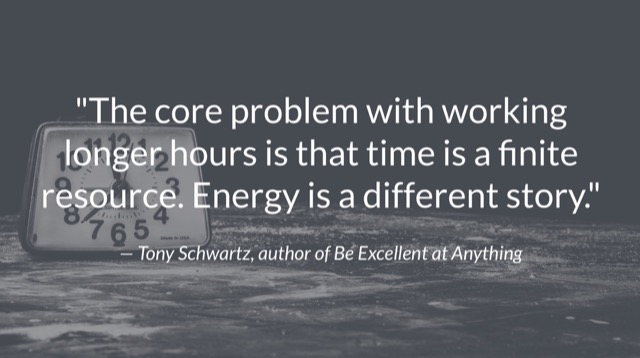
Commit to a Weekly Plan
As mentioned previously, one of the challenges that entrepreneurs face is making sure the thing that you are working on is what you should be working on. I have found that writing out my plan for the week has been one of the greatest productivity boosters in my arsenal.
Making sure that each day has a task or two that must be done to reach my goals ensures that I work on the important, not just what I feel like doing for the day. Entrepreneur James Clear states:
“If you do the most important thing first, then you’ll never have a day when you didn’t get something important done.” – James Clear
On Sunday evening, I open a text document and write out each of the days of the week. For each of those days, I write down at least one thing that I need to accomplish that day to reach my weekly goals. There have been weeks where I skipped this step due to the business of life, and I feel it throughout the week until I sit down and plan out a task for the remaining days of the week. The unplanned weeks are the ones I waste the most time on the non-essential tasks that jump in front of me, and I don’t end up any closer to my goals.
This tip can be expanded out from a weekly plan to a monthly plan, which gives each week a few concrete jobs to accomplish, or a yearly plan that gives each month a specific set of goals.
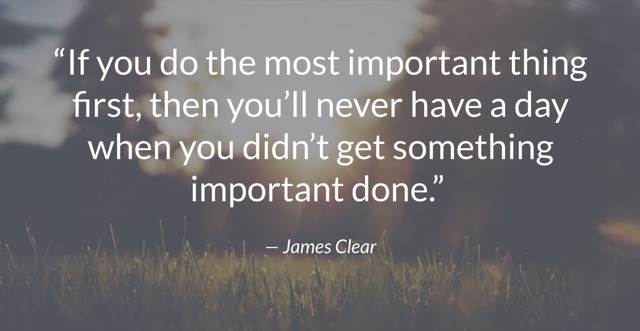
Free up Time With Essentialism
Recently I have heard many entrepreneurs talking about a book by Greg McKeown called Essentialism: The Disciplined Pursuit of Less. Essentially, McKeown strikes a nerve by calling out our frequent inability to discern what is essential, and eliminate the rest. He reminds us that when we say “yes” by agreeing to that meeting, reading and responding to all of those emails, and getting distracted by whatever is in front of our eyes, we empower others to set our agenda:
“Remember that if you don’t prioritize your life someone else will.”
Greg McKeown
My favorite saying in this regard is “If it isn’t a ‘Hell Yes, then it is a ‘no’”. Does someone want to grab coffee? Has a small project come across your plate? What is your gut feeling when you receive this request?
Of course, this bears some disclaimer. You can be an amazing essentialist and lose all of your friends and network. However, this doesn’t mean that you have to say “yes” to everything to maintain friendships and professional relationships–you just need to say “yes” to only the essentials. Perhaps meeting for coffee once a month instead of once a week is in order. Perhaps saying “no” to that small project opens up your time to work on something that will be more of a game-changer.
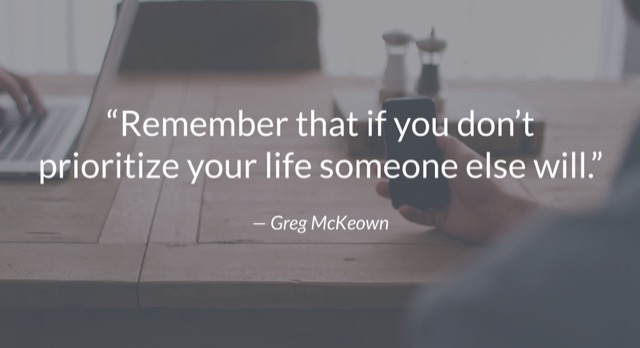
Lookout for the 80/20
In 1896, Italian economist Vilfredo Pareto published a paper explaining that roughly 80% of the land in Italy was owned by 20% of the population. He also noticed that about 20% of the pea pods in his garden produced 80% of the pea yield. The point is, in many areas of life, there is a minority that produces the majority, while the majority produces the minority.
The exact ratio of 80/20 is not an absolute ratio by any means, and in some cases, it might be 95/5, or 75/25. However, it is important to note in what ways this principle plays out in how you spend your time.
- What are the 80% of tasks that only move you forward 20%?
- What are the 20% of activities over the past year that have given you nearly 80% of your success?
- What are the 20% of the people in your network that give you 80% of the encouragement and motivation?
- What are the 20% of the projects or activities that provide 80% of your income?
- Who are the 20% of customers that provide you 80% of your income?
Once you identify the minority that has the majority of the effect, you can spend your time and energy investing in those people and activities to maximize effectiveness. Author Stephen Covey writes:
“The key is in not spending time, but in investing it.” – Stephen R. Covey
We all spend 24 hours a day whether we want to or not. How we spend that time is another matter, and some tasks provide more return than others.
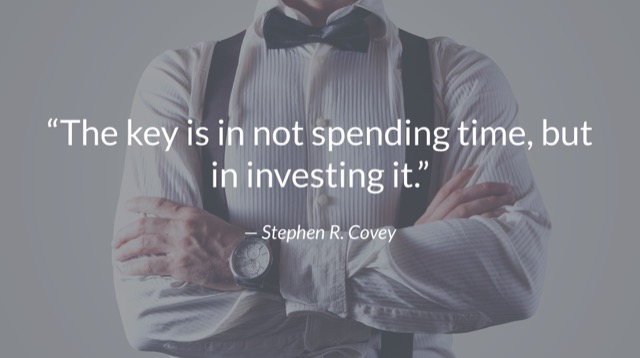
Time Boxing with Pomodoro
When you have 4 hours to accomplish what appears to be 5 hours of work, you get that work done in 4 hours. When you have 10 hours to accomplish the same tasks, you somehow find a way to allow it to take 10 hours. We are wired to work faster under constraints. That is the concept that Francesco Cirillo leveraged in the late 1980s when he introduced the “Pomodoro Method”.
“Pomodoro” is the Italian word for tomato, the shape of a common kitchen timer in many kitchens. Cirillo explained that we can accomplish more by setting a timer for a fixed amount of time (traditionally 25 minutes) and working on a specific task during that time. After that session (referred to as “a Pomodoro”), you take a short 3-5 minute break. After four Pomodoro, you take a longer 15-20 minute break.
Of course, not every task can be accomplished within a 25-minute sprint, so some tasks might be broken up into multiple Pomodoro. With this method, you know that you can’t stop what you are doing to make a quick phone call or check your email. If your mind remembers that you are going to start a composting pile after work, you don’t stop what you are doing to research composting piles. Speaker and author Zig Ziglar state:
Lack of direction, not lack of time, is the problem. We all have twenty-four hour days.” – Zig Ziglar
By planning out the tasks to be done, and giving them dedicated sprints of work, we force upon ourselves a sense of urgency throughout the day. That same sense of urgency that I mentioned before makes me more productive from 4:00 pm – to 5:00 pm, knowing that the end of the day is near and I need to kick it into high gear.
This time-boxing technique can also extend into other creative practices, like shifting your location throughout the day. Instead of spending the whole day at the office, try giving yourself 2 hours at the coffee shop in the morning to accomplish a certain task, then heading over to the library for another 2-hour sprint for another task. Knowing that you have a certain time frame to accomplish a certain task, then taking a short break and either driving to another location or walking around to give your brain some extra oxygen is a surefire way to ensure that you accomplish more than you would by simply sitting down for 8 hours and working at a leisurely pace.
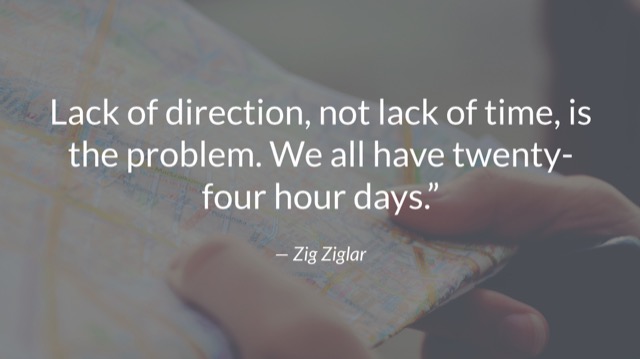
Reduce Friction with Batching
Does your workday involve a variety of tasks? Take note of how much time it takes to transition from activity to activity. For example, when I make a phone call, I get out paper for notes, put in my earpieces, and find a quiet location. If I made all of my phone calls for the day at once, I only have to do that once, instead of random times throughout the day. Speaker and author Michael Hyatt shares:
Working in a perpetual state of shifting tasks and refocusing attention creates fatigue, stress, and decreased productivity. -Michael Hyatt
The benefits of batching can be applied on a weekly level as well. For example, some people schedule all of their phone calls or meetings for a particular day each week. John Lee Dumas has a daily podcast, but he records all 7 of his episodes each week in one day. Whether it is on a weekly or daily level, batching similar tasks together reduces the friction of shifting activities and saves time.
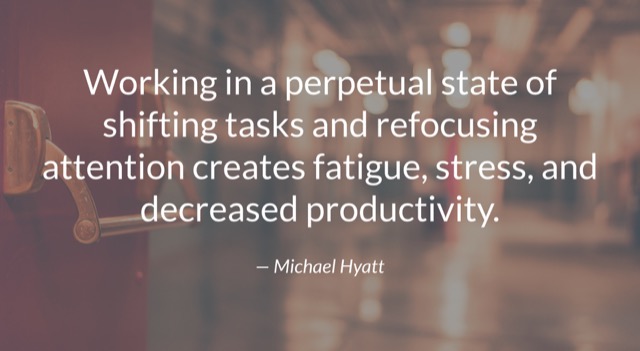
Prioritize with GTD
All of these time-saving techniques are useless if you aren’t working on the tasks that need to be done. The best book I’ve read by far in regards to planning out your daily tasks is David Allen’s Getting Things Done: The Art of Stress-Free Productivity (the methods of which are often shortened to “GTD”). Allen outlines a method of getting ideas and tasks out of our heads and into an actionable system. According to Allen:
“Your mind is for having ideas, not holding them.” —David Allen
Allen instructs his clients to first do a mental dump of all of the tasks floating around in their heads. Whether it is on paper or within task management software. Next, his clients set up a single inbox where all of the tasks moving forward need to be dumped for processing. This could be a physical bin, a computer folder, or a section of the task management software. From there, each task can have one of the following applied:
- Do it: If it takes less than 2 minutes, just do it.
- Defer it: Put it on the calendar or under a project list to be acted upon later.
- Delegate it: Assign someone else the responsibility of completing the task.
With GTD, you also need to have a weekly review to check over the active projects that are on your lists and choose which ones are going to be worked on next.
This is an over-simplification of the system, but the point is that your mind is no place to organize all of these tasks and priorities without writing them down first. When you write them down, and regularly review these tasks, you can be sure that nothing slips through the cracks, and your attention is given to the important tasks that get results.
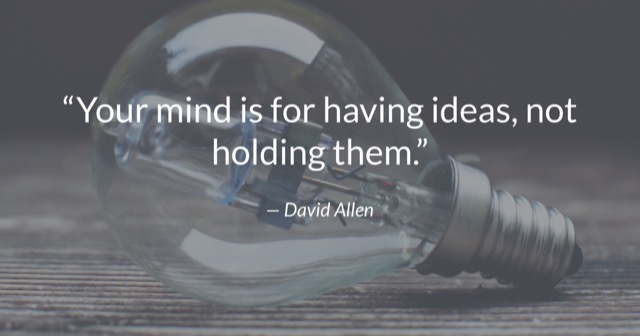
Conclusion
Imagine a couple of 30-year-olds who grew up in the same neighborhood with similar family situations. One goes on to build and launch a company that gets acquired for millions of dollars on his 29th birthday, and one ends up working a 9-5 corporate job for decent pay, but has no savings and generally hates his workweek. Assuming that they both had the same opportunities presented to them from the start, the key difference between them is how they spent those years between childhood and 30 years old. They both had the same amount of time, how they spent it was the difference.
Perhaps your goal is less about monetary gain and more about quality of life, time spent with family and friends, or the ability to travel without time restraints. Whatever your life’s goals, consistently applying time management strategies will ensure that you make maximum progress towards them, instead of getting distracted and working towards the wrong goals, or worse yet, towards nothing at all.